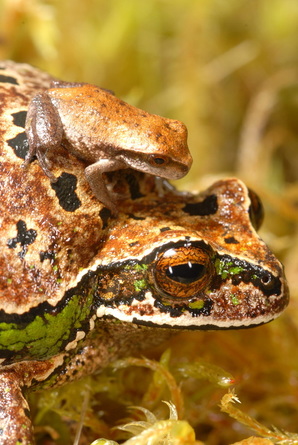
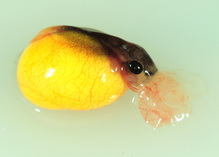
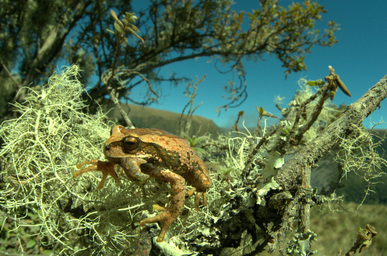
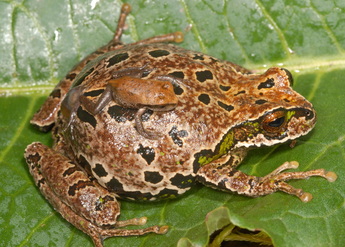
 A new lab contribution published today in Biology Letters documents for the first time the occurrence of maternal nutrient transfer to embryos developing in the dorsal pouch in marsupial frogs. These Central and South American hemiphractid frogs (genus Gastrotheca) reproduce like no other frog. The female lays eggs externally and the male fertilizes them, but unlike any other frog he then introduces the eggs into the female’s dorsal brooding pouch. In this protected environment, embryos develop until hatching either as tadpoles, or, in the majority of species, as fully developed and miniature versions of the adults - such as the young Gastrotheca excubitor in this picture. The ancestral condition in this group is direct development, and marsupial frogs are the only group of frogs in which species laying feeding tadpoles have evolved from direct developing ancestors, with reversal to direct development in some derived species.  The embryos of the most derived marsupial frogs have gigantic bell-shaped gills, a unique characteristic only shared with other genera in the family. These modified gills likely play an important role in acquiring maternally derived nutrients during embryonic development. Our new study, which is a collaboration with our colleague Robin Warne, provides two lines of evidence supporting the idea that mothers provide nutrients to embryos.  First, brooding females were fed with isotopically enriched prey. Each prey was sprinkled with an amino acid high in δ15N and a fatty acid high in δ13C. We were then able to track this isotopic enrichment in the tissues of the mother, as well as the tissues of the developing embryos. The isotopic enrichment in 15N embryos increased non-linearly with development, suggesting that amino acid demand increases with development in rapidly growing embryos and then declines near metamorphosis.  The second line of evidence is that embryo dry mass increased with developmental stage. Earlier researchers had hypothesized that the large gills of marsupial frog embryos might allow exchange of nutrients, and measured embryo mass change in tadpole-laying species without finding evidence of such exchange. Our findings in direct-developing Gastrotheca excubitor show that ancestral features for gas exchange for developing embryos may indeed be co-opted for nutrient transfer, and provide insight into the evolution of matrotrophy in vertebrates.
4 Comments
Alessandro will be giving a seminar at the University of Genoa, Italy on 16 December at 1pm, about the impact of fungal disease and climate warming on amphibians.
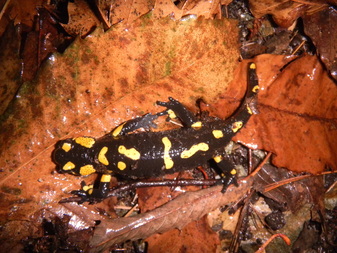 A lab contribution (Parrott et al.) published today in the journal EcoHealth surveys chytrid diseases Batrachochytritium dendrobatidis (Bd) and B. salamandrivorans (Bsal) in three mountain ranges in Europe and the Americas. Screening of over 500 salamanders found that Bd was present at low prevalence at most sites, and at high prevalence in the Andean foothills. Bsal was not found at any of the sites, supporting the idea that Bsal is an emergent disease, and that its spread must be prevented to preserve salamander biodiversity. Alessandro will be given a seminar at the University of Michigan, as part of the Ecology and Evolutionary Biology Tuesday Lunch Seminars. The talk will be on Tuesday, October 11, 2016 from lunch-1pm at 2009 Ruthven Museums Building, Ann Arbor. The title of the talk is Will mountaintop tropical frogs raise to the heavens in response to disease and climate change?
Two lab members will be presenting at the SIU Natural Science Research Symposium in the Auditorium of Morris Library on 7 October. Alex will be giving a talk at 10 am titled Bd prevalence in rebounding and remnant amphibian populations, whereas Josh will be giving a poster at 3-4:30 pm titled Survey of pathogenic chytrid fungi in salamanders from three mountain ranges in Europe and the Americas.
|
Archives
June 2024
CATENAZZI LABNews from the lab Categories |